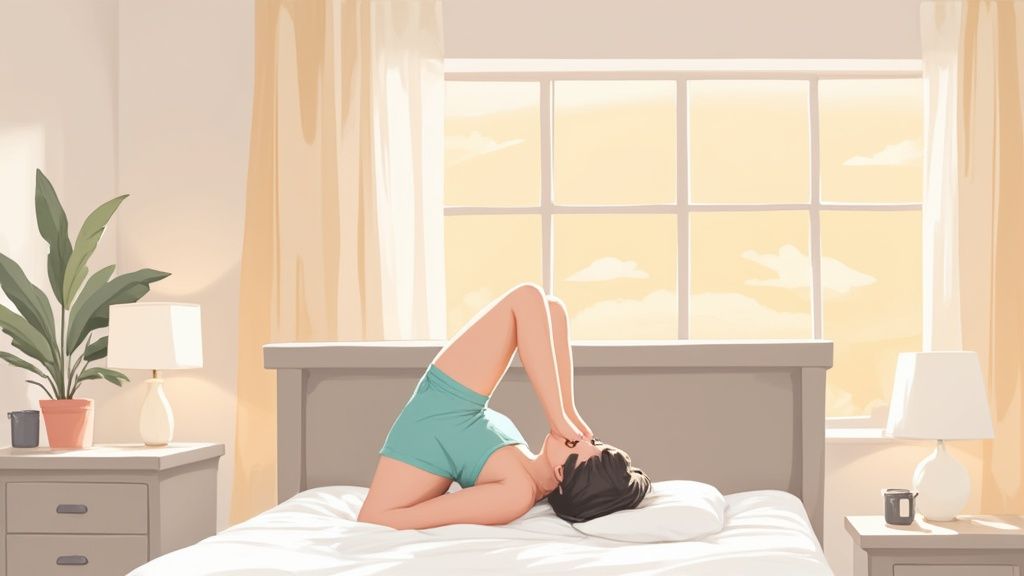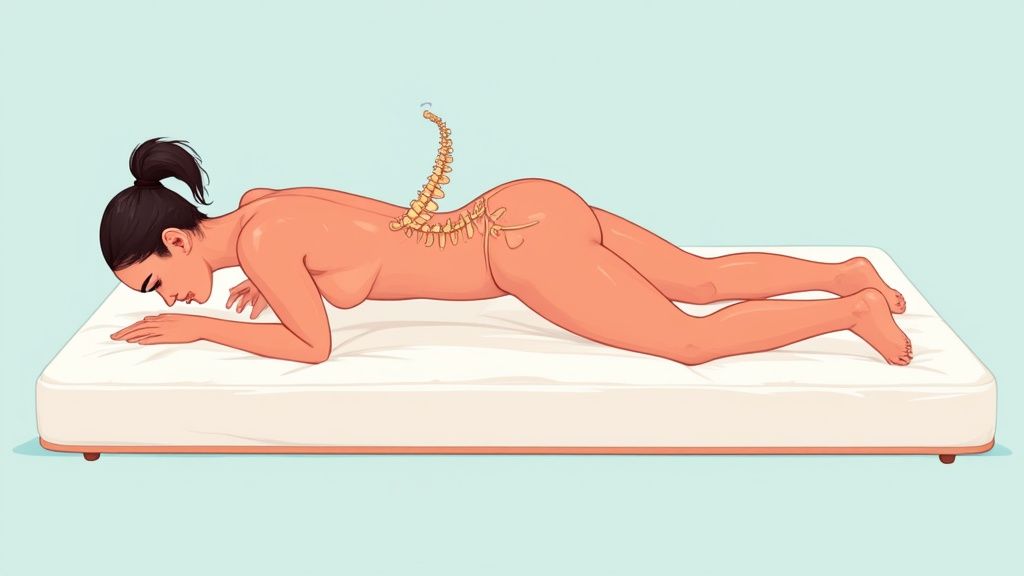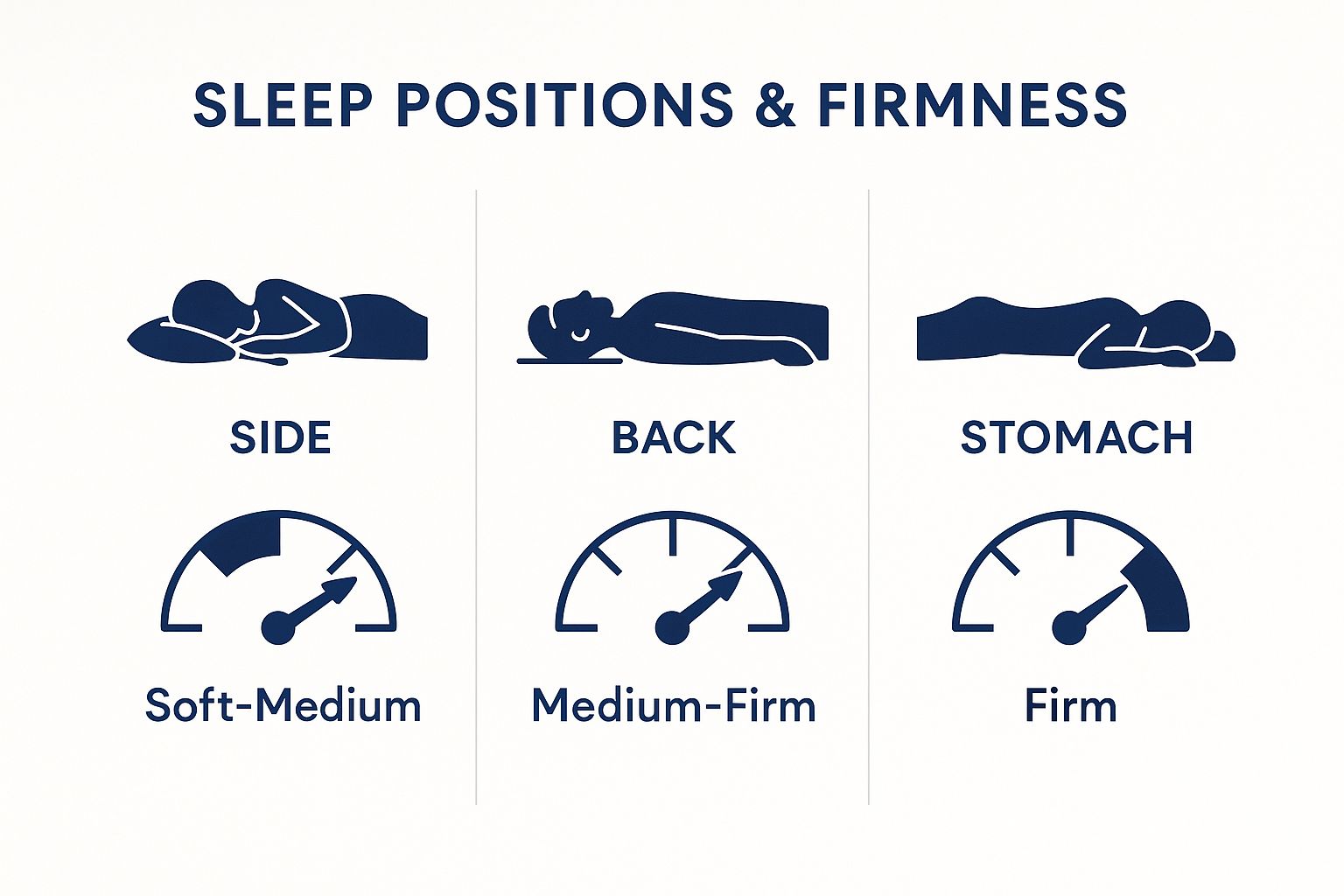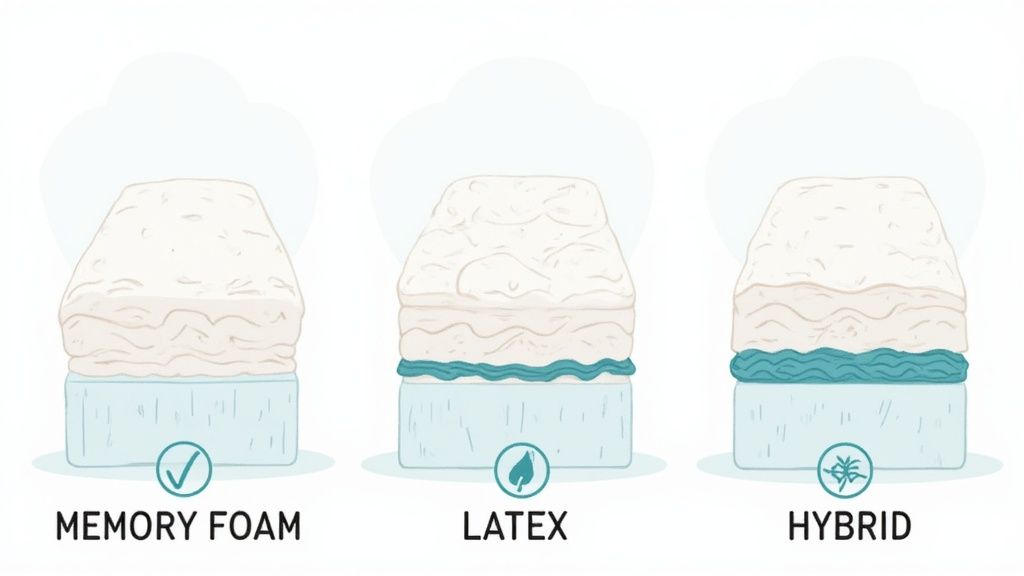Waking up with an aching back is a miserable way to start the day. If that sounds painfully familiar, your mattress could be the real culprit. Finding the best mattress for back pain in NZ isn’t just about picking something soft; it’s about striking the perfect balance between support, comfort, and spinal alignment.
Your Guide to a Pain-Free Morning

You're not alone if back pain is wrecking your mornings. Thousands of Kiwis are in the same boat, but the good news is that the right mattress can make a world of difference. This guide will help you cut through the marketing jargon and focus on what truly matters for lasting relief.
It's a huge problem here at home. In fact, up to 80% of New Zealanders will suffer from low back pain at some point in their lives, yet surprisingly few connect it to their bed. A truly supportive mattress is one of the most effective first steps you can take towards better mornings and a healthier spine.
A great mattress does more than just feel good for a night. It actively works to keep your spine in its natural, neutral alignment, helping to prevent pain and allowing your body to properly recover while you sleep.
Often, the problem is an old, worn-out mattress that’s lost its supportive mojo. If your bed is sagging in the middle or you can feel the springs, it’s a clear sign it's time for an upgrade. Unsure if yours is past its prime? Our guide on when you need to replace your mattress is the first step toward reclaiming a pain-free start to your day.
Why Spinal Alignment Is Non-Negotiable

Think of your spine as the central pillar of your body. All day long, your muscles are on duty, working hard to keep everything upright and aligned. When you lie down at night, that crucial job gets handed over to your mattress.
The goal is to maintain spinal alignment—a straight, neutral line from your head right down to your tailbone. It’s the secret to waking up refreshed instead of stiff and sore.
If your mattress is too soft, your hips and shoulders will sink in too far, creating an unhealthy "hammock" effect that strains your back. On the other hand, a mattress that’s too firm won’t give way to your body’s natural curves, leading to uncomfortable pressure points and pushing your spine out of line.
This isn't just a minor issue; it's a significant one here at home. Studies show New Zealand is a global hotspot for low back pain, particularly for people aged 15 to 49. Getting your spinal alignment right is your number one defence against becoming part of that statistic.
Support vs. Firmness: What's the Difference?
People often mix up 'support' and 'firmness', but they are two very different things. Getting this right is probably the most important step in finding a mattress that actually helps your back pain.
- Firmness is all about that initial feeling—how hard or soft the mattress feels when you first lie on it. It’s what you notice straight away and is mostly about personal comfort.
- Support is the hidden hero. It’s the mattress’s ability to keep your spine straight and in a neutral position, no matter how soft the top layers feel.
You can have a mattress that feels luxuriously soft on the surface but has a rock-solid support core underneath. That’s the magic combination.
The perfect mattress delivers uncompromising support to keep your spine perfectly aligned, with a firmness level that feels just right for you.
Proper support is what stops you from waking up sore. The best mattresses are cleverly designed to push back where you need it most, preventing that dreaded sag and keeping your spine in its happy place all night long.
If you have specific back concerns, it's worth looking into specialised designs. You can explore the top advantages of investing in orthopedic mattresses in our detailed guide.
Choosing the Right Firmness for Your Sleep Style
We’ve all heard the old Kiwi advice that a rock-hard mattress is the only way to fix a sore back. But honestly, that’s a bit of a myth. The truth is, the best mattress firmness for you has everything to do with your body and how you sleep, not some generic “one-size-fits-all” label.
Think of it as finding that perfect balance—the sweet spot between a surface that props you up and one that cradles you comfortably. Go too firm, and you'll get nasty pressure points on your hips and shoulders. Go too soft, and your spine will sag like a hammock. Either way, you're waking up feeling stiff and sorry for yourself.
That’s why the single most important clue to finding your ideal mattress is your favourite sleeping position.
Match Firmness to Your Sleep Position
The way you sleep determines where your body needs support and where it needs a bit of give to stay aligned all night long.
-
Side Sleepers: If you sleep on your side, you'll want a slightly softer surface (soft to medium-firm). This allows your hips and shoulders to sink in just the right amount, taking the pressure off those major joints and keeping your spine in a nice, straight line.
-
Back Sleepers: For back sleepers, the main job is to support the natural curve of your lower back. A medium-firm mattress is usually the winner here, as it stops your hips from dropping too low and maintains fantastic spinal alignment.
-
Stomach Sleepers: This position can be a real strain on your neck and back. You’ll need a firm mattress to keep your hips from sinking, which helps keep your spine as neutral as possible and prevents it from arching unnaturally.
This infographic lays it out perfectly, showing how your sleep style points you toward the right firmness.

As you can see, a one-size-fits-all approach just doesn't cut it. Side sleepers need that gentle contouring, while stomach sleepers need solid, unwavering support. To get into the nitty-gritty of it all, take a look at our guide explaining why mattress firmness matters.
Decoding Mattress Materials: Foam, Latex, or Hybrid?

Once you’ve got a handle on the firmness level you need, the next big decision is the material. Walking into a mattress showroom in NZ can feel a bit overwhelming with all the different options, but for back pain, it generally comes down to three heavy hitters: memory foam, latex, and hybrid mattresses.
There’s no single "best" material here. It’s all about finding the one that feels right for your body and what you need for a good night’s sleep.
The Contouring Cradler: Memory Foam
Memory foam is famous for that signature "hugging" sensation. It uses your own body heat to soften and mould precisely to your curves, which is fantastic for relieving pressure. If you've got sharp, nagging pain points—especially around your hips and shoulders—the deep contouring of memory foam can feel like pure bliss.
But that cosy hug does come with a couple of things to keep in mind. Some traditional memory foams can trap heat, which isn't ideal if you tend to sleep warm. Also, because it responds slowly, some people find it takes a bit more effort to change positions during the night.
The Buoyant Supporter: Latex
Latex offers a completely different feel from memory foam. Instead of sinking in, you sleep on top of a latex mattress. It has a natural buoyancy and a springy, responsive feel that provides incredible spinal support without ever making you feel trapped.
On top of that, it's known for being incredibly durable and naturally breathable, so it’s a great long-term investment that helps keep you cool.
While memory foam cradles and contours, latex lifts and supports. Think of it as the difference between being gently held versus being lightly floated. This distinction is key to finding the best mattress for back pain in NZ that suits your personal comfort style.
The main hurdle for some Kiwis is the price, as high-quality natural latex is usually at the premium end of the market.
The Best of Both Worlds: Hybrid
Can’t decide between springs and foam? That's where hybrid mattresses come in. They’re designed to give you the benefits of both by combining a supportive core of pocketed coils with generous comfort layers of memory foam or latex on top.
This clever construction delivers a fantastic all-around solution for back pain:
- Targeted Support: The coils provide a strong, often zoned foundation that keeps your spine properly aligned.
- Pressure Relief: You still get that crucial cushioning for your joints from the foam or latex layers.
- Excellent Airflow: The space around the coils allows air to circulate freely, making hybrids a top choice for hot sleepers.
Ultimately, hybrids give you the responsive "lift" of springs with the conforming comfort of foam, which is why they’ve become one of the most popular and effective choices for Kiwis struggling with back pain.
Mattress Material Comparison for Back Pain Sufferers
To help you weigh the options, here’s a quick breakdown of how these materials stack up when it comes to managing back pain.
| Material | Key Benefit for Back Pain | Potential Drawback | Ideal Sleeper |
|---|---|---|---|
| Memory Foam | Exceptional pressure point relief; contours to the body's natural curves. | Can retain heat; some find it difficult to move on. | Side sleepers and those with sharp, localised pain. |
| Latex | Responsive support that keeps the spine aligned; naturally buoyant feel. | Can be more expensive; some dislike the bouncy sensation. | Back, stomach, and combination sleepers who want support without sinking. |
| Hybrid | A balanced blend of contouring comfort and robust, zoned support. | Can be heavy and expensive; quality varies significantly. | Anyone wanting the benefits of both foam and coils; great for hot sleepers. |
Each material brings something unique to the table. Your personal preference for feel—whether you like to sink in or float on top—will be the deciding factor.
Matching Your Mattress to Your Specific Back Pain
https://www.youtube.com/embed/X-WZcEazeyU
Knowing the theory is one thing, but applying it to your specific aches and pains is where you’ll find genuine relief. Let's be honest, not all back pain feels the same, so your checklist for the best mattress for back pain in NZ needs to focus on your personal problem areas.
This isn't a small issue for Kiwis. Chronic low back pain takes a huge toll, not just on our well-being but on the whole economy through healthcare costs and lost work days. In fact, data from New Zealand's Accident Compensation Corporation (ACC) shows that claims for spinal and lower back injuries have cost millions in recent years. You can explore the national statistics here.
What this means is that choosing the right mattress is more than just a preference—it's a critical decision for your health.
Solutions for Common Back Pain
So, how do we translate your specific pain into the right mattress features? By figuring out exactly where it hurts, you can zero in on the mattress components that will give you the best support and comfort.
-
Persistent Lower Back Ache: This is a classic sign that your hips aren't getting enough support. You'll want to look for a mattress with a strong, supportive core. Zoned support, which is firmer through the middle third of the mattress, is brilliant for this, as it stops your hips from dipping and keeps your spine straight.
-
Upper Back and Neck Tension: If you're waking up with a sore neck and shoulders, your mattress might be too hard, creating pressure points. This is especially true for side sleepers, who need softer comfort layers to let their shoulders sink in just enough to relieve tension.
-
Sciatica and Radiating Pain: For anyone dealing with the shooting pain of sciatica, pressure relief is absolutely essential. Materials like memory foam or natural latex are your best friends here. They mould to your body's curves, cradling the lower back and hips to avoid putting any extra stress on that sensitive sciatic nerve.
At the end of the day, the goal is simple: find a sleep surface that lets your spine rest in a completely neutral, natural position. Your mattress should fill in the gaps and support your curves, not force your body into an awkward shape.
When you match the mattress features to your type of pain, you stop guessing and start making a strategic choice for better sleep. For a bit of real-world inspiration, check out this customer success story about finding the perfect mattress for back pain relief.
Frequently Asked Questions
Even when you've done your research, a few final questions often pop up before you make a decision. We get it. To help you feel completely confident in your choice, here are some straight-up answers to the questions we hear most often from Kiwis searching for back pain relief.
How Long Does It Take to Adjust to a New Mattress?
Give your body at least 30 nights to fully adapt to a new mattress. Think about it: your muscles have likely spent years overcompensating for an old, unsupportive bed. It takes a little while for them to relax and learn to trust the new support system.
That’s why most top Kiwi brands offer trial periods of 100 nights or more. It gives you more than enough time to be absolutely sure the mattress is the right one for your back.
Is an Orthopaedic Mattress Always Best for Back Pain?
Not necessarily. Here in New Zealand, the term "orthopaedic" is mostly a marketing buzzword that usually just means the mattress is extra-firm. While some people need that rigid surface, it can actually make things worse for others by creating painful pressure points, especially for side sleepers.
Don't get caught up in the label—focus on how the mattress actually performs. The goal is to find a bed with the right support system for your body and a firmness level that matches your weight and sleep style, regardless of what it's called.
Can a Mattress Topper Fix My Sore Back?
A topper can be a great short-term fix if your current mattress is just a bit too firm. It adds a welcome layer of softness and cushioning.
But it’s really just a band-aid solution for a mattress that's truly past its prime. If your bed is sagging and the core support has given up, a topper won't stop your spine from dipping out of alignment. For real, lasting relief, the only answer is a new mattress.
If you have more questions, head over to our full company FAQs page, where we cover everything from delivery details to warranty information.
Ready to find the perfect mattress to soothe your back pain? At New Zealand Bed Company, our sleep experts can guide you to the ideal solution for your needs. Explore our range of supportive mattresses today and start your journey to a pain-free morning.
Article created using Outrank

